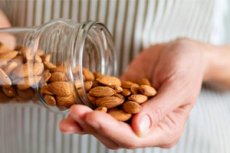New publications
Almonds against 'oxidative wear': Doses over 60g per day reduce DNA and lipid damage
Last reviewed: 18.08.2025

All iLive content is medically reviewed or fact checked to ensure as much factual accuracy as possible.
We have strict sourcing guidelines and only link to reputable media sites, academic research institutions and, whenever possible, medically peer reviewed studies. Note that the numbers in parentheses ([1], [2], etc.) are clickable links to these studies.
If you feel that any of our content is inaccurate, out-of-date, or otherwise questionable, please select it and press Ctrl + Enter.

Oxidative stress is when there are too many reactive oxygen species and the body’s own antioxidant systems are not enough, and then lipids, proteins and DNA come under attack. A team of Iranian nutritionists tested whether almonds – rich in vitamin E, polyphenols and monounsaturated fats – can significantly “extinguish” this stress in humans. A systematic review and meta-analysis of randomized trials was published in Scientific Reports: the authors collected eight clinical studies (five RCTs and three cross-over trials, a total of 424 participants) and looked at what happens to markers of oxidation and antioxidant protection – from malondialdehyde (MDA, a product of lipid peroxidation) to 8-hydroxy-2′-deoxyguanosine (8-OHdG, an indicator of oxidative DNA damage), superoxide dismutase (SOD) and uric acid. The sample included both healthy volunteers and people with risk factors: overweight, hyperlipidemia, coronary heart disease and even smokers; almond doses ranged from 5 to 168 g per day, duration - from 4 to 24 weeks.
The main conclusion of the meta-analysis is that almonds have a dose-dependent antioxidant effect, and the “working threshold” turned out to be a portion over 60 g/day. It was at these amounts that the key markers of oxidative stress statistically significantly decreased: MDA fell (average weighted difference -0.46; p = 0.002), 8-OHdG significantly decreased (-5.83; p < 0.001), and uric acid decreased (-0.64; p = 0.009). At the same time, SOD increased on average (+2.02; p = 0.008), which indicates increased enzymatic protection. No effect on glutathione peroxidase (GPx) was found - the data spread is too large. When the researchers looked at more modest portions (< 60 g/day), there was no longer a significant improvement in MDA - another argument in favor of the threshold dose.
At the same time, the authors honestly emphasize: heterogeneity is high (I² for a number of indicators reached 92-96%), and this is not only about different doses and duration. The results are affected by the form of the product and processing methods. Several included studies used whole raw nuts, while others used roasted, blanched (with the skin removed), powder or oil. And it is in the skin that a significant proportion of polyphenols is concentrated: blanching almost “zeroes” them, and frying, judging by food chemistry data, reduces the total pool of phenols by about a quarter and reduces the antioxidant capacity according to FRAP by about a third. Hence, the logical practical conclusion of the researchers for future RCTs: standardize the form (preferably whole unblanched almonds), fix the dose ≥ 60 g / day, drag out the intervention for at least 12 weeks and use consistent laboratory methods. Then the “noise” between studies will be less.
Context is also important. The effect is greater in groups with increased oxidative stress to begin with (such as smokers or patients with chronic diseases), while in healthy people the “ceiling” of improvement is lower – simply because everything is closer to normal to begin with. Taken together, the picture is clear: almonds are a functional food with a synergy of fats, vitamin E and polyphenols, but the real scale of the benefit in prevention and maintenance therapy depends on the dose, form and the person’s initial status.
There are limitations, too. The meta-analysis included only eight clinical studies with small sample sizes; some of the studies were cross-over studies; and the variety of doses, durations, and forms of almond administration created heterogeneity that required caution in interpreting the overall estimates. But even with these caveats, the signal remains robust: if the dose is high (more than 60 g/day) and the skins are preserved, markers of oxidative damage to lipids and DNA are improved in people on average. The next step is large, standardized RCTs with uniform protocols and stratification by baseline oxidative stress.
Source: Kolahi A. et al. “The impact of almond supplementation on oxidative stress biomarkers: a systematic review and meta-analysis of randomized control trials,” Scientific Reports, August 13, 2025. https://doi.org/10.1038/s41598-025-14701-w
